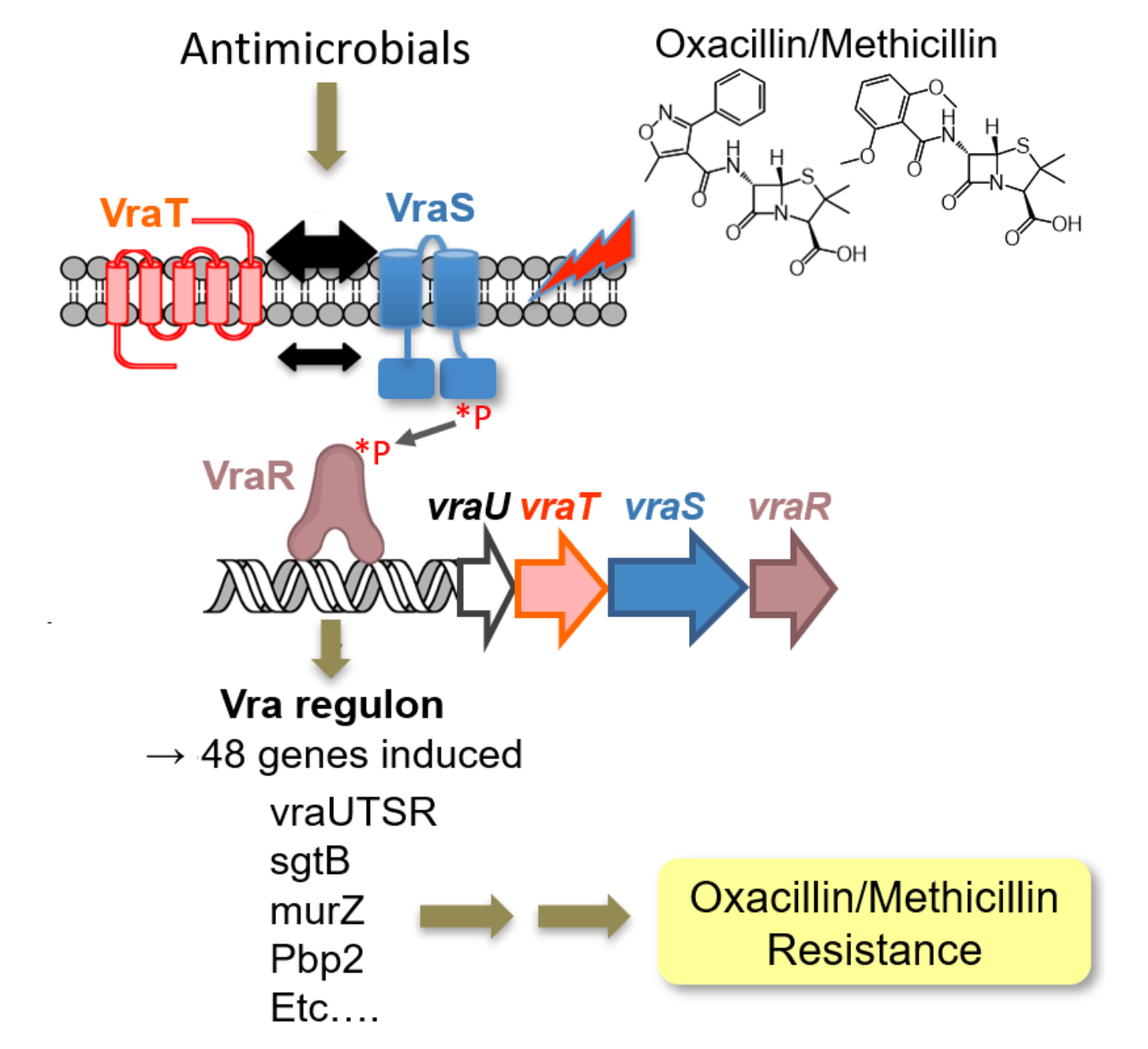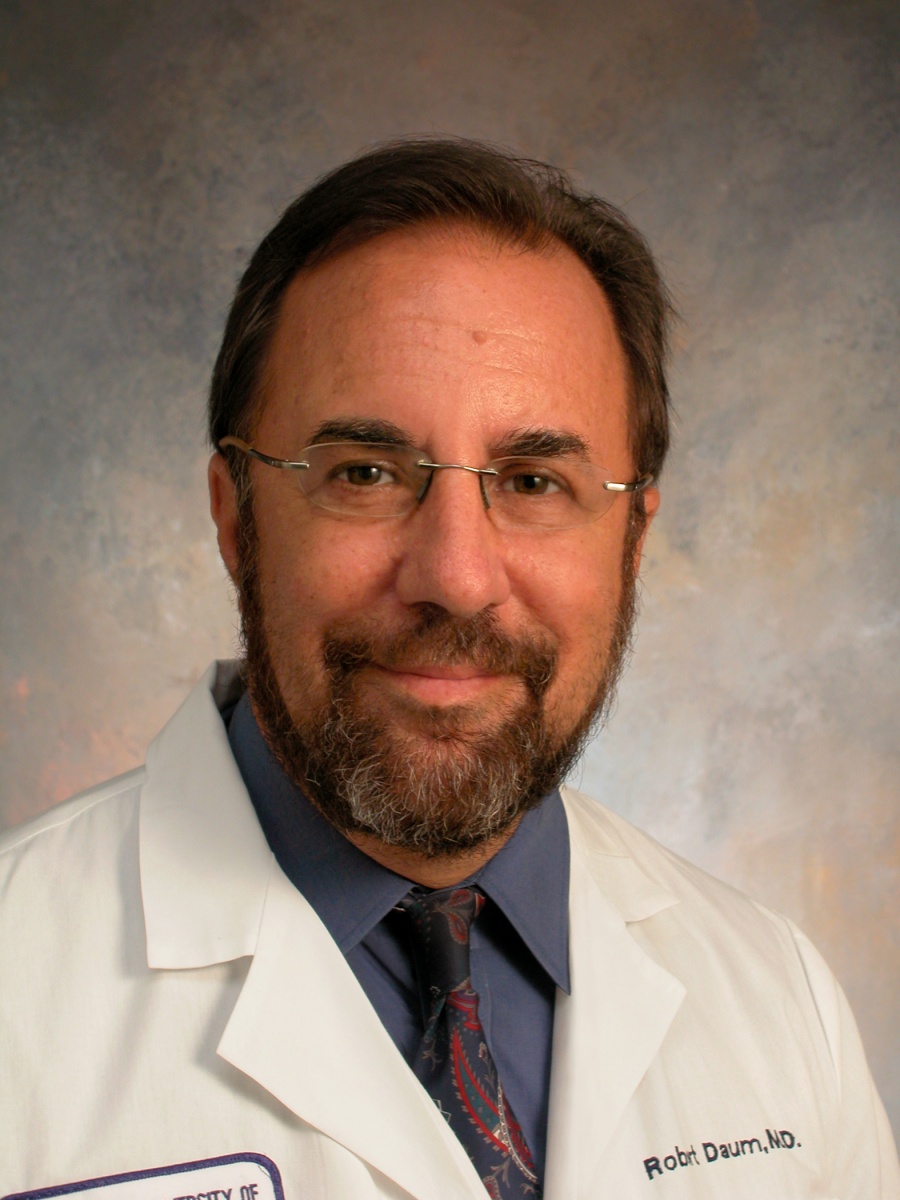August 1, 2019 | Jola Glotzer
Fighting MRSA
A Catalyst Team of Michael Johnson, UIC and Robert Daum, UChicago, identify three novel compounds that restore oxacillin efficacy against the methicillin resistant Staphylococcus aureus (MRSA)
Congratulations to the Catalyst Team of Michael Johnson, UIC and Robert Daum, UChicago (currently at the University of Maryland Medical Center), on a recent publication in Antimicrobial Agents and Chemotherapy, titled “Identification of small molecules exhibiting oxacillin synergy through a novel assay for inhibition of vraTSR expression in methicillin resistant Staphylococcus aureus.” The published work is attributed in part to a CBC Catalyst Award in 2013 for the project: “A novel antimicrobial strategy against methicillin-resistant S. aureus (MRSA).”
Methicillin-resistant Staphylococcus aureus (MRSA) strains are in fact resistant to all forms of penicillin. Hence, MRSA-caused diseases, which range from difficult-to-heal skin abscess to life-threatening infections, are becoming increasingly common calling for urgent intervention and the development of new effective therapeutic methods.
In the current study, the authors describe a novel MRSA cell-based assay, which, combined with a high-throughput screening (HTS) of an antimicrobial-focused Life Chemicals library, led to the identification of three potentiators of the antibiotic oxacillin. The reported findings provide a starting-point for characterizing and optimizing the compounds, and eventually, developing new MRSA therapeutics.
Daum and Johnson are co-senior authors on the CBC Catalyst Award-attributed publication. At the time of the award, Daum was Professor of Pediatrics and MRSA Research Center Principal Investigator at UChicago. Johnson is Professor Emeritus at the Center for Biomolecular Sciences, UIC. In addition to the Catalyst, Johnson received also three CBC HTS Awards (2015, 2014 and 2013, respectively) to conduct small molecule screens for compounds against different pathogens, including MRSA. Worth mentioning is that the first author on the study, Hyun Lee, who is Director of Biophysics Core and Research Assistant Professor at the Department of Medicinal Chemistry and Pharmacognosy was co-PI on the 2015 CBC HTS Award titled “Identification and Development of Small Molecules that Inhibit the VraSRT Operon, which Maintains Oxacillin Resistance in Methicillin-resistant S. aureus (MRSA).” Johnson’s other CBC Awards and ties to the CBC, including serving on the CBC Catalyst Review Board (2006-2010) are listed below. The CBC is grateful to Johnson for his time and commitment to the CBC programming and wishes him continuous success in his scientific career.
Publication attributed to CBC funding*:
Lee H, Boyle-Vavra S, Ren J, Jarusiewicz J, Sharma LK, Hoagland DT, Yin S, Zhu T, Hevener KE, Ojeda I, Lee RE, Daum RS, Johnson ME. Identification of small molecules exhibiting oxacillin synergy through a novel assay for inhibition of vraTSR expression in methicillin resistant Staphylococcus aureus. Antimicrob Agents Chemother. 2019 Jun 17. [Epub ahead of print] (PubMed)
ABSTRACT:

Model for signal transduction between VraTSR and antibiotic resistance. Cell wall stress imparts a signal that leads to phosphorylation of VraS, which in turn leads to phosphorylation of VraR that subsequently activates a regulon of about 48 genes in the cell wall stress response. (Source: aac.asm.org)
Methicillin-resistant Staphylococcus aureus (MRSA) strains that are resistant to all forms of penicillin have become an increasingly common and urgent problem threatening human health. They are responsible for a wide variety of infectious diseases ranging from minor skin abscesses to life-threatening severe infections. The vra operon that is conserved among S. aureus strains encodes a three-component signal transduction system (vraTSR) that is responsible for sensing and responding to cell-wall stress. We developed a novel and multi-faceted assay to identify compounds that potentiate the activity of oxacillin, essentially restoring efficacy of oxacillin against MRSA, and performed high-throughput screening (HTS) to identify oxacillin potentiators. HTS of 13,840 small molecule compounds from an antimicrobial-focused Life Chemicals library, using the MRSA cell-based assay, identified three different inhibitor scaffolds. Checkerboard assays for synergy with oxacillin, RT-PCR assays against vraR expression and direct confirmation of interaction with VraS by surface plasmon resonance (SPR) further verified them to be viable hit compounds. Subsequent structure-activity relationship (SAR) study of the best scaffold with diverse analogs was utilized to improve potency and provides a strong foundation for further development.
ACKNOWLEDGMENTS:
Reported by PI Michael Johnson, UIC, during the CBC annual data collection (Dec. 2018) as partially funded by a *CBC Catalyst Award (2013; see below).
Featured CBC Community member(s):
Robert Daum, UChicago
Currently at the University of Maryland School of Medicine
- *CBC Catalyst Award (2013):
▸ A novel antimicrobial strategy against methicillin-resistant S. aureus (MRSA)
PIs: Robert Daum (UChicago) and Michael Johnson, (UIC)
Michael Johnson, UIC
- CBC Accelerator Award (Finalist, 2019):
▸ Inhaled colony stimulating factor 1 receptor inhibitor for asthma therapy
PIs: Gye Young Park and Michael Johnson, (UIC) - CBC Accelerator Award (Finalist, 2018):
▸ Establish Animal Efficacy Proof of Concept for Highly Active Antimicrobial Leads
PIs: Leslie Fung and Michael Johnson, (UIC) - CBC HTS Award (2015):
▸ Identification and Development of Small Molecules that Inhibit the VraSRT Operon, which Maintains Oxacillin Resistance in Methicillin-resistant S. aureus (MRSA)
PIs: Hyun Lee and Michael Johnson, (UIC) - CBC HTS Award (2014):
▸ Identification and Development of Small Molecule Inhibitors Against Middle East Respiratory Syndrome Coronavirus (MERS-CoV)
PIs: Hyun Lee and Michael Johnson, (UIC) - *CBC Catalyst Award (2013):
▸ A novel antimicrobial strategy against methicillin-resistant S. aureus (MRSA)
PIs: Robert Daum (UChicago) and Michael Johnson, (UIC) - CBC Exploratory Workshop (2013):
▸ The CBC Exploratory Workshop on Lipoproteins
Michael Johnson, (UIC) — Workshop Speaker - CBC HTS Award (2013):
▸ Virtual and High-throughput Screening for Anti-hemophilia Drugs that Target the Protein Z-dependent Protease Inhibitor-protein Z (ZPI-PZ) Interaction
PIs: Xin Huang, Steven Olson and Michael Johnson, (UIC) - CBC Tech Day (2012):
▸ Small Molecule Discovery in Academia
Michael Johnson, (UIC) — Tech Day Speaker - CBC Scholar Award (2013):
▸ Meet the Scholar: Rima Chaudhuri
PIs: Rima Chaudhuri and Michael Johnson, (mentor, UIC) - CBC Catalyst Review Board (2006-2010):
▸ Current Membership
Michael Johnson, (UIC) — Board Member
ARTICLES PUBLISHED IN THE PAST ABOUT THE FEATURED CBC COMMUNITY MEMBER(S):
June 26, 2019
▸ Screening for drugs against MERS
Twice CBC Awardees — Hyun Lee and Michael Johnson (UIC) — identify new compounds with a therapeutic potential against the coronavirus causing Middle East Respiratory Syndrome (MERS)


